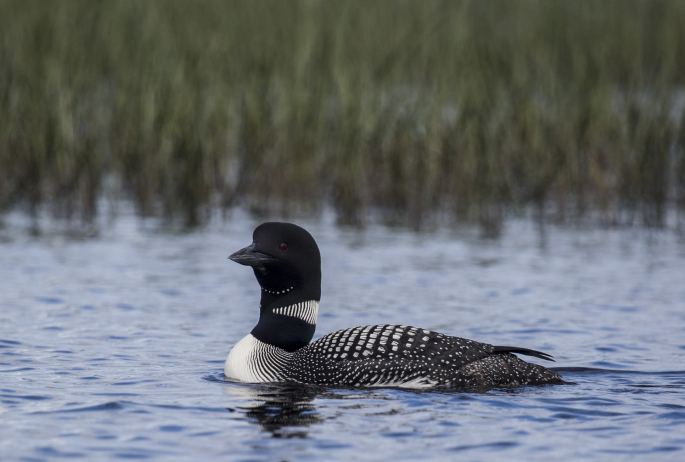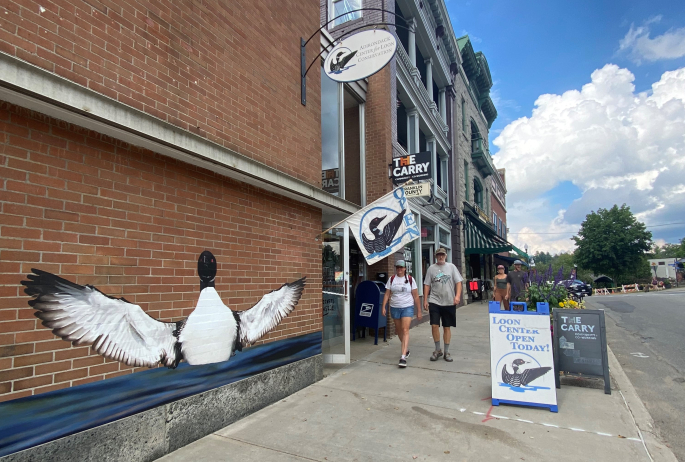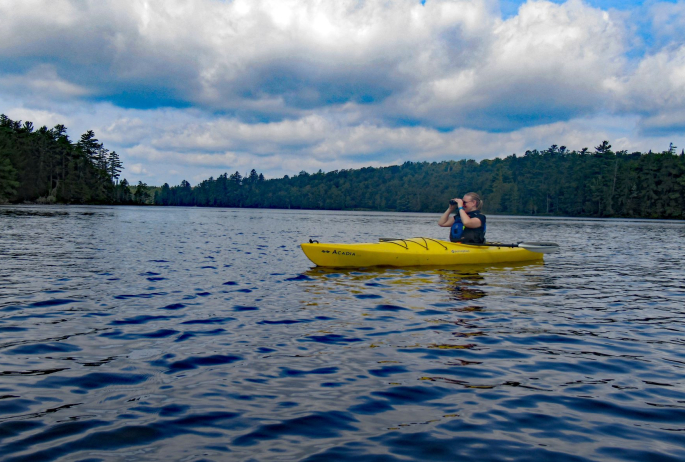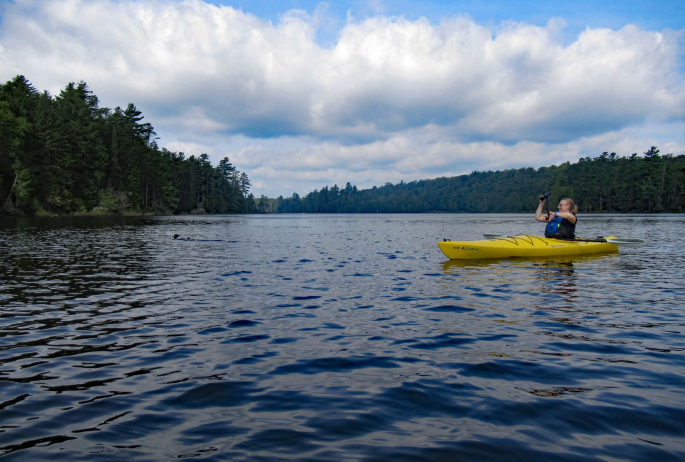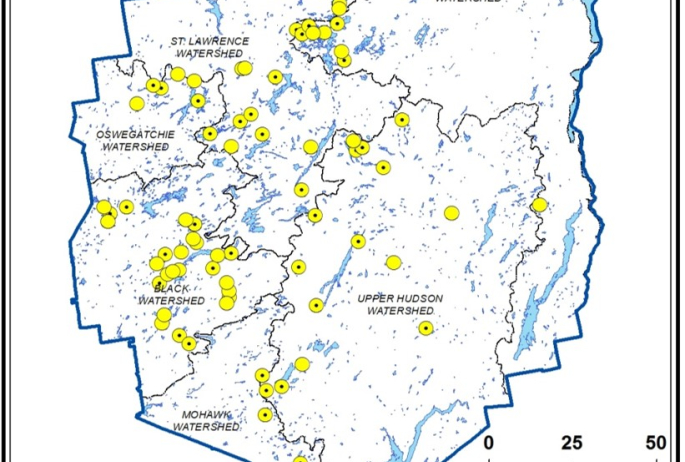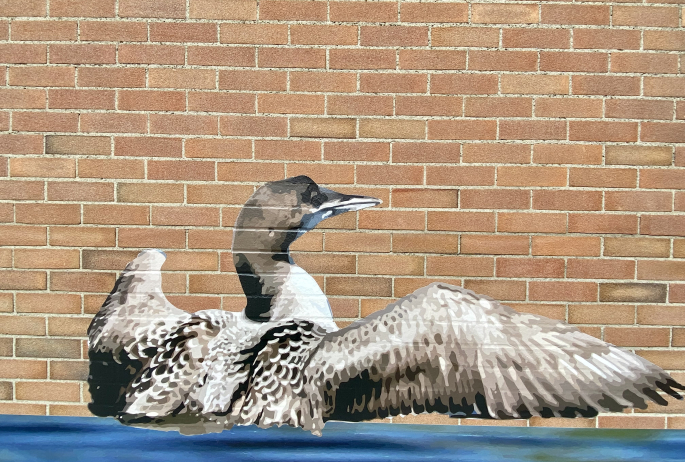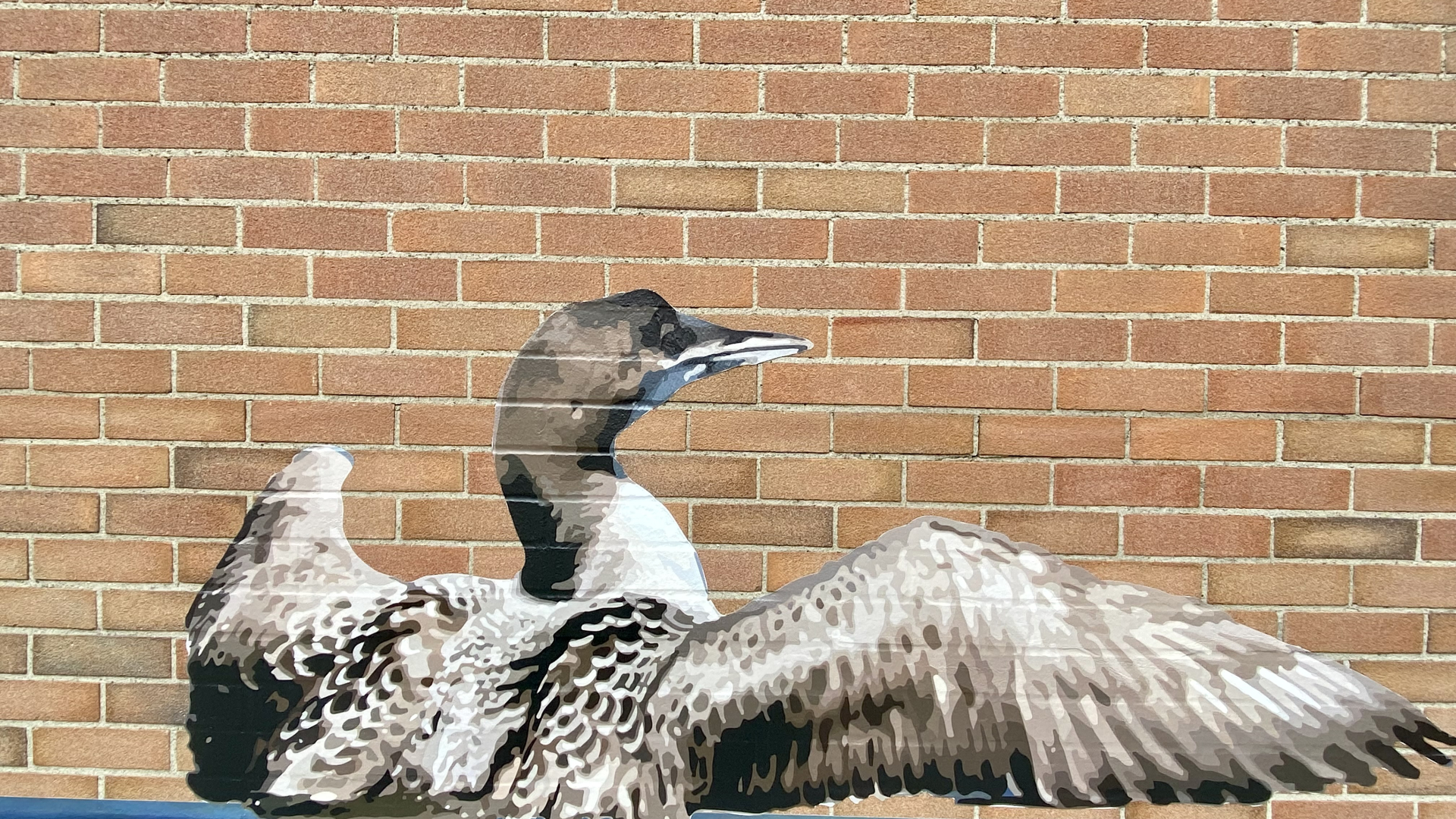Sydney Aveson
September 12, 2022
The Adirondacks are known for a lot of things: Adirondack chairs, maple syrup, flannels, logging, fishing, and the great outdoors. But none of these things are as iconic as the Common Loon (Gavia immer). People flock to the Adirondacks and paddle its pristine lakes for a chance to hear a loon's wolf-like wail. But oftentimes, that's as far as people's knowledge goes. As an avid paddler and self-proclaimed naturalist, I am here to tell you there is so much more to these majestic creatures.
Loons have long been recognized as a symbol of pristine wilderness, which is why they are so important to protect. Dr. Nina Schoch, executive director of the Adirondack Center for Loon Conservation (ACLC) says, “We are using loons as environmental sentinels because they are at the top of the food web, so they serve as informants for the health of lake ecosystems. Additionally, they are a charismatic species, so they are a great environmental educational tool to talk to people about environmental concerns and conservation tools to protect the ecosystems and habitats that wildlife use.”
The creation of a loon center

The ACLC developed from scientific research on the impact of mercury pollution on aquatic ecosystems, using loons as an indicator species. To conduct the study, researchers take a blood and feather sample to test a loon for mercury levels. This research is in its 24th year and ultimately served as the catalyst for the creation of the non-profit organization in 2017. Since its inception, the ACLC has continued to evolve in more ways than one. So even if you have visited the ACLC in the past, it's worth going back to.
What's new at the ACLC?
- The ACLC recently moved to Main Street in July 2021, making it more accessible to the public.
- The organization has adopted new conservation programs, including the lead tackle buy-back program, which started in 2021 (see more below).
- A migration exhibit is launching this fall with the help of Charlie Reinertsen, who is an exhibit developer with The Wild Center in Tupper Lake.
- Beautiful loon murals now adorn the brick walls in front of the ACLC building.
Conservation programs
Lead tackle buy-back program
Sadly, lead poisoning is a leading cause of death in loons, eagles, and other species. This happens when these birds eat a fish that has swallowed a lead jig or sinker. A simple solution is to educate anglers about the importance of fishing with non-lead tackle and to remove lead tackle from Adirondack waterways. In July 2021, the ACLC received a 5 year grant to do just that. The program partners with retailers across the Adirondacks by accepting lead tackle turn-ins. In exchange, retailers will give customers a $10 voucher for replacement tackle. It really is a win-win-win situation. Lead tackle comes out of circulation, it attracts new people to local businesses, and anglers get new tackle out. Additionally, it serves as an educational opportunity about how lead poisons wildlife, including loons. This initiative will hopefully help increase reproductive success and reduce the threats that can cause loon mortality before the loons ever interact with those threats. This project is funded through grants from Blake Nuttall Ornithological Fund, Glenn and Carol Pearsall Adirondack Foundation, and the US Fish and Wildlife Service on behalf of the Bouchard Barge 120 Buzzards Bay Oil Spill Trustees.
Fishing line recycling program
Loons and other wildlife run the risk of getting tangled in fishing line that isn't recovered. Fishing is a popular activity in the summer months, so this poses a real risk. Fishing line can get tangled under the water or in vegetation, which can cause loons to get tangled. Entaglement can prevent a loon from eating or cause unnecessary injury and infection. Fortunately, this environmental problem has an easy solution. The ACLC educates people about the importance of recycling fishing line and picking up abandoned fishing line. The ACLC also offers fishing line recycling containers to interested community groups. There is no charge for these containers, but donations are always welcome. Volunteers maintain these containers and recycle any line that is discarded in them. As an example, The Lake Clear Association empties their receptacle every week, an indicator that the program is making a noticeable difference.
Adirondack loon-friendly lake certification program
This program promotes community-based environmental stewardship by providing lake associations and other interested groups with guidelines, trainings, and certification projects to ensure that their respective lake continues to support breeding loons for years to come. Adirondack Loon-Friendly Lake Certification projects include:
1. Organizing 2-3 community lake cleanups each year
2. Providing ACLC brochures to lake residents and rental properties to educate visitors about loon-safe boating and recreation,
3. Placing “Help Protect Loons” signage at boat launches
4. Installing and maintaining a Fishing Line Recycling Container at your lake
5. Collecting and recycling lead fishing tackle, and more!
Over 30 lakes have gone through the process of becoming a loon-friendy lake. The ACLC hopes to increase this number to 50 lakes within the next 4 years and they are certainly on tract to meet that goal. To learn more about this program, contact the ACLC at info@adkloon.org or 518-354-8636 to set up a training workshop. Remember, small actions will make a big difference to the loons on your lake.
Other threats facing loons
The effects of climate change are causing two major problems: reduced nesting success due to torrential rain events and the “molt-migration mis-match,” where the birds used to migrate in November-December when the lakes start to freeze over. Now, however, loons are moving from smaller Adirondack lakes to larger ones like Lake Champlain and Lake George, instead of going south. When these lakes eventually freeze in late-January and February, the birds have molted their feathers so they can’t fly, so they get stuck. Last year, the ACLC rescued 3 loons on Lake George and 5 on Lake Champlain. Climate change can also cause more exposure to diseases like malaria and black flies can cause nest failure because the loons don’t want to sit on their nests and get eaten alive. Additionally, eggs need a certain temperature to develop, so global warming is certainly a concern. Loons in southern states will move further north to compensate for rises in temperature. Loons have a lot of down underneath their black feathers, so loons in the south are at risk of overheating.
Loon 101

Common Loons are waterbirds, meaning they are great swimmers, so much so their other common name is the Great Northern Diver. In order to dive, their bones aren't hollow like other birds. While this helps with diving, heavy bones make it very difficult for loons to fly. Read below for some fun facts about loons.
- Loons can fly 200 or more miles in a day and they can fly non-stop for 8 hours or more.
- Loons can fly up to 70 miles per hour.
- Adult loons weigh between 6-14 pounds.
- Loons can dive up to 200 feet.
- Loons dive for an average of 45 seconds, but can be as long as 2-3 minutes.
- Loons can imprint within 10-20 mile radius from where they are born.
- Banding studies have shown that loons can have several mates over their lifetime.
- Loon can live for 25-30 years. The first adult loon that was banded in the Adirondacks in 1998 was just 3-4 years old. In 2018, 20 years later, this same loon was still raising chicks.
- Loons typically come back to the same lake year after year, so they are very territorial.
- Loons molt all of their flight feathers at once and stay flightless during the winter.
- Loons have iconic red eyes, but they dull in color while they are in their winter plumage.
The language of loons
Loons make six important vocalizations that all communicate something different. It's easy and fun to learn these sounds. Here are a few behaviors to get you started.
- Hoot: A short sound used to communicate. If you are near a loon and it’s making this noise, back away. You are bothering it!
- Tremelo: Agitation or distress call. Loons also make this sound while they’re flying.
- Wail: Used to announce where they are.
- Yodel: Male loons will yodel and "penguin dance" when they are distressed. Large birds of prey like bald eagles can inspire them to yodel, as can people. This is a visual warning for those invading their territory.
- Loons “foot-wag” when they are relaxed and comfortable. It may also help them thermoregulate.
Want to learn more about loons?
- Attend a public presentation
- Join ACLC staff for a loon field trip (once per month in the summer). These field trips are a 4-hour paddling tour of an Adirondack lake and are a great opportunity to visit some of the organizations study loons and learn about these beautiful birds.
- Sign-up for the Adirondack Tremelo, a newsletter that includes updates, events, and other news with the organization.
- Read about the ACLC's research on the Adirondack Loon populations. You can learn about the impacts of environmental pollutants on loons, their migratory patterns and wintering areas, trends in the Adirondack breeding loon population, factors affecting nesting success, and more!
If you are walking along Main Street in Saranac Lake, be sure to stop by the Adirondack Center for Loon Conservation. Say hi to the amazing staff doing this important work, browse the exhibits, and check out their store. All store purchases help support the ACLC loon programs, which helps sustain the work they do.
